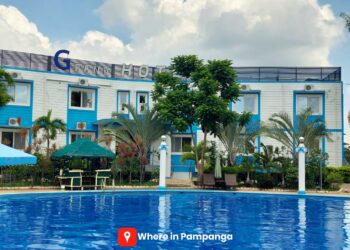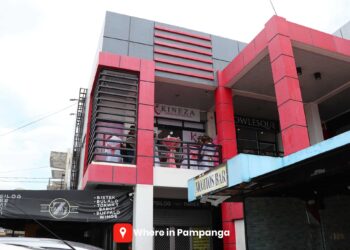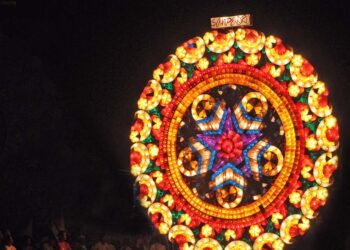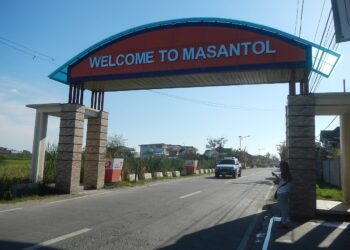The Municipality of Guagua is a 1st class municipality located in the southwestern part of the Province of Pampanga.
The Municipality of Guagua is bounded on the north by the townships of Bacolor and Santa Rita; on the south by the municipalities of Sasmuan and Lubao; on the east, Macabebe and Sasmuan; and on the west, Porac and Floridablanca.
Guagua is acknowledged as the “Balayan Nung Arte” or Town of Arts in English. In the primary year of American rule in the country, the children of Guagua became patrons of the Renaissance of culture and art.
History
Based on some documents as early as the 1590s, the earliest accounted form of the name of the Municipality of Guagua was the word ‘Wawa,’ is a Hindu-Malayan origin emitted from the colloquial word ‘Alwa’ or ‘Alawa,” which means “the mouth of the river.” Another factor was the location of the place wherein, it was strategically situated alongside a river which played an important part in the industry of trade and means of transport during the pre-colonial time.
The town of Wawa was already an affluent settlement when Spanish settlers has taken control of the town in the year 1561. However, it was only in the year 1590, that the Augustinian friars changed the original name “Wawa” into “Guagua.”
There was no clear clarification on why they decided to change the initial name. It was suspected by one historian that maybe the inappropriateness of the word “Wawa” in the local Kapampangan language, which means ‘saliva’ could have instigated the Spanish Friars to change the name into ‘Guagua’. Besides, the word ‘Wawa’ also refers to a body of water. Coincidentally, the word ‘Guagua’ could have originated from the Spanish word ‘aqua,’ which means water.
The early settlers had chosen to stay in Guagua for the reason, that they could easily be involved in barter trade with people from different isles, alongside other sources of income such as fishing and farming.
On May 7, 1884, the first cargo boat to reach the town of Guagua was the Doña Dominga. Later on, it was succeeded by the steamships Kaibigan and Kababayan, which anchored at the pier in Bgy Santo Niño, commonly known as the Yañgco Landing.
The town of Guagua was virtually the harbor of the boarding to and from Manila that served the province, – when the Manila-Mabalacat railroad was launched in 1892.
The Chinese have been around for a long time and are a part of the widespread economic and social customs of Guagua. They seek shelter in the town of Guagua to avoid the xenophobia and persecution that occurred in the 18th century.
After, avoiding an almost complete massacre, the Chinese people in Guagua town lived together with the residents while working on their crafts and socializing freely. The Chinese people were traders, stonemasons, woodcarvers, carpenters, agriculturists, and laborers. Their impact on the cultural and economic life of Guagua cannot be ignored. The town could not have thrived so well without the fiscal services contributed by the Chinese.
The town of Guagua carried out an important part in the revolutionary struggle against the foreign colonizers. In August 1897, a house nearby a church served as a secret hideout of the Katipuneros.
A massacre of all Spanish supporters that occurred in Guagua highlighted the cease of the Spanish Imperial Government and the beginning of American rule. Most significantly, Guagua was transformed into an important battleground during the duration of the Philippine- American war and the following World War II.
By the 20th century, a new system of education was made known and prevalent, and accessible to the Filipinos. The Guagua Elementary School in Brgy. Santa Filomena-, is reported to be the first to be instituted in the municipality in the year 1901.
Later that year, an English teacher arrived in Betis Area and started a grammar school that’s being officiated regularly.
In 1908, Colegio del Sagrado Corazón de Jesús, which is now St Mary’s Academy in Brgy.San Roque was instituted in a two-story building given by a generous matron, in downtown Guagua.
Afterward in 1918, Guagua National Institute known now as Guagua National Colleges in Brgy. Santa Filomena was created at the convent of the Catholic church.
Moreover, the then-parish priest considered the demand for another high school in Guagua town, therefore he started Saint Michael’s College in 1941.
Barangay
The Municipality of Guagua is divided into four districts and subdivided into 31 barangays.
| Bancal |
| Plaza Burgos |
| San Nicolas 1st |
| San Pedro |
| San Rafael |
| San Roque |
| Santa Filomena |
| Santo Cristo |
| Santo Niño |
| San Vicente (Ebus) |
| Lambac |
| Magsaysay |
| Maquiapo |
| Natividad |
| Pulungmasle |
| Rizal |
| Ascomo |
| Jose Abad Santos (Siran) |
| San Pablo |
| San Juan 1st |
| San Jose |
| San Matias |
| San Isidro |
| San Antonio |
| San Agustin |
| San Juan Bautista |
| San Juan Nepomuceno |
| San Miguel |
| San Nicolas 2nd |
| Santa Ines |
| Santa Ursula |
San Rafael was established on Dock Island in 1956.
Festivals
Aldo ning Guagua
A festivity honoring Immaculate Conception, Guagua’s town patroness. The festival is held annually every November 28 to Dec 8.
Dukit Festival
A Celebration of arts and creativity of the people of Betis, Pampanga. The Dukit Festival started in 2008 showcasing the traditional woodcarving and the culture of arts of the people of Betis, which they are known for.
The festival held on Dec. 27-28 is part of the festivity of the feast of St. James the Great, patron of Betis, Guagua, which parish church is called the “Sistine Chapel of the Philippines.”
Tilapia Festival
It is a festivity of gratitude and commendation for Guagua’s part as one of the biggest Tilapia producers in the Philippines held every December 6.
Landmark and Attraction
Saint James the Apostle Parish Church
Considered a National Cultural Treasure by the National Museum of the Philippines. Also known as “Santiago Apostol Parish Church” or in short “Betis Church.” It’s constructed in 1607.
Immaculate Conception Parish Church
The first church organization was established in 1587, however, it was destroyed by fire. The present-day structure of the church was constructed in 1722 under the management of the Augustinians. Furthermore, the church was well maintained and improved from 1862 until 1870. It’s an 18th-century Roman Catholic church, with a marker from the National Historical Commission of the Philippines
The Lopez Mansion (The Guagua Mansion)
Erected in 1929 by the affluent tycoon, Don Alejandro Lopez of Guagua. It was created as the first all-concrete house in Pampanga and in the 1935 telephone directory, the house was called “The Pride of Guagua Pampanga”. The Lopez Mansion was rehabilitated in 2016, functioning as an events venue, and was given a new name as “The Guagua Mansion.”
Rizal Monument
Situated in Barangay Plaza Burgos.
Guagua Municipal Hall
Constructed in 1937.The office of the elected Mayor and other elected officers.
References:
*https://en.wikipedia.org/wiki/Guagua
*https://www.primidi.com/guagua_pampanga/history
*https://www.philatlas.com/luzon/r03/pampanga/guagua.html
*https://www.pampanga.gov.ph/index.php/about-pampanga-2/189-capitol/tourism/municipality/330-guagua.html
*https://www.pampanga.gov.ph/index.php/about-pampanga-2/143-capitol/districts/district-ii/guagua/333-municipality-of-guagua.html
*For corrections or commentaries, please email us at whereinpampanga@gmail.com



















